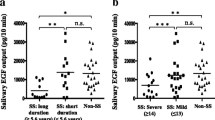Abstract
Previous investigations have found elevated levels of s-IgA in the parotid saliva and normal levels in submandibular saliva of patients with Sjögren's syndrome (SS). Fox et al. also found elevated levels of cytokines (i.e., IL-2 and IL-6) in serum, salivary epithelial cells and parotid saliva of patients with SS. The oral administration of pilocarpine hydrochloride stimulates whole and parotid salivary flow. The purpose of this study was to determine the levels of s-IgA and IL-2 and IL-6 in whole saliva before and after administration of pilocarpine hydrochloride in SS subjects. Ten definitively diagnosed SS subjects were enrolled in the study, as were ten controls (C). The mean age was 57.2 years and all subjects were female. Whole unstimulated saliva (WUS) was collected by standard techniques for 5 min, after which the volume and flow rate were determined (mean WUS: SS = 0.047 vs C = 0.480 ml/min). Samples were centrifuged and the immunoglobulin analysis performed on the supernatants by immunoreactivity in a double-sandwich technique as previously described by Rudney et al. Cytokine analysis was performed similarly utilizing commercially available kits from R&D Systems. The results as analyzed by pairwise t-tests revealed comparable levels of s-IgA in the saliva of the SS patients, as compared to controls at baseline (means±SEM: SS-IgA = 348.1±82.0 vs C-IgA = 284.0±65.1 μg/ml; NS ). Whole salivary flow was significantly increased (328%) in the SS subject group 60 min after the administration of 5 mg pilocarpine hydrochloride (means±SEM: 0.0472±0.017 vs 0.1546±0.054 ml/min; P<0.01). There was no significant change in the concentration of s-IgA in the SS subject group following the pilocarpine dose (means±SEM: SS-IgA = 439.9±121.2 μl/ml; P = NS). There were elevated levels of IL-2 in the saliva of four out of the ten and IL-6 in two out of the ten SS patients, as compared to controls (means±SEM: SS-IL-2 = 127.8±11.4 vs C-IL-2 = 30.8±1.6 pg/ml and SS-IL-6 = 41.4±7.1 vs C-11.6 ± 2.8 pg/ml). There was also a significant decrease in the concentration of IL-2 in the same four out of ten SS subjects following the pilocarpine dose (means±SEM: SS-IL-2 = 32.4±10.3; P<0.01). These preliminary results indicate that s-IgA levels do not change with increased salivary flow following the administration of pilocarpine hydrochloride in patients with Sjögren's syndrome. While cytokines are elevated in the whole saliva of some SS patients, a decrease in IL-2 concentration may occur with increased salivary flow.
Similar content being viewed by others
Author information
Authors and Affiliations
Additional information
Received: 4 May 1998 / Accepted: 21 October 1998
Rights and permissions
About this article
Cite this article
Rhodus, N., Dahmer, L., Lindemann, K. et al. s-IgA and cytokine levels in whole saliva of Sjögren's syndrome patients before and after oral pilocarpine hydrochloride administration: a pilot study. Clinical Oral Investigations 2, 191–196 (1998). https://doi.org/10.1007/s007840050069
Issue Date:
DOI: https://doi.org/10.1007/s007840050069




